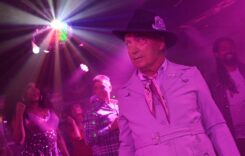AUGUST 1, 2016
The conventions are over, and I’m taking the day off from writing about Trump and Clinton. So let’s go to the movies!
First up, an annual summer ritual — the latest movie from Woody Allen.
“Café Society” is Allen’s 47th (!!!) film, and it is by far the most beautiful-looking film I’ve seen this year. It was shot by Italian cinematographer Vittorio Storaro, whose legendary work includes such classic films as “The Conformist,” “Last Tango in Paris” and “Apocalypse Now.” Frankly, I thought the 76 year-old Storaro had retired long ago, so it was an absolute thrill to see that he not only is still at the top of his game but he has very new things to show us.
Take the first shot of “Café Society.” It’s a simple master shot of a poolside cocktail party. But the lighting and composition of the shot are absolutely breathtaking. I gasped out loud, and the audience members around me probably thought I was nuts. And how he photographs Kristen Stewart? We’ll get back to that in a second.
Did I mention that Woody Allen had something to do with this movie? “Café Society” is set in the place that Allen is most comfortable these days — the past. Here it’s the 1930s, and Bobby Dorfman (Jesse Eisenberg) wants to leave New York to try to make his fortune in Hollywood with the help of his superagent uncle Phil (Steve Carell).
After Bobby finally gets a meeting to see his uncle, Phil pawns him off on his assistant Vonnie (Stewart) who shows him around Hollywood, a town that doesn’t particularly impress her. Bobby falls hard for Vonnie. She is drawn to Bobby as well, but she tells him that she can’t date him because she is seeing a journalist named Doug. (In reality, she is actually dating a very-married man for whom she works and whom we know very well.)
Heartbroken, Bobby returns to New York and gets into the nightclub business with his gangster brother Ben (Corey Stoll, very hoodlum-like). Bobby’s untapped social skills soon make him the toast of the town, and his nightclub quickly becomes the hottest hot spot in New York. But of all the gin joints in the world, who should decide to stroll in one night and see a lost love?
At this point in his storied career, Allen is tending to take one step forward and two steps back. For example, the wonderful “Vicky Christina Barcelona” (which brought Penelope Cruz an Oscar) was followed by the entirely forgettable “Anything Goes” (2009) and “You Will Met a Tall Dark Stranger” (2010). (Does anyone even remember those?) Then came the great “Midnight in Paris” (2011) (which brought Allen a screenplay Oscar) followed by the inconsequential “To Rome With Love” (2012). Allen returned to the winner’s circle with “Blue Jasmine” (2013) (which garnered a Best Actress Oscar for Cate Blanchett) which then led to the mediocre “Magic in the Moonlight” (2014) and the genuinely awful “Irrational Man” (2015).
“Café Society” places Allen on an upswing, though it’s not nearly as good as “Midnight in Paris” or “Blue Jasmine.” Once Bobby leaves Hollywood, the forward momentum that the story has achieved stops and has to start all over again to tell the New York part of the story, which hurts its pacing. But the performances that Allen has drawn from his cast do a lot to bridge that gap. Eisenberg is probably the best voice-of-Woody since Kenneth Branagh did Woody in 1998’s “Celebrity.” There’s a wonderful scene that Eisenberg has with a novice hooker (Anna Camp) where, if you close your eyes, you can hear him channeling the Woody Allen of 50 years ago. In fact, Allen himself is the narrator of “Café Society,” and it’s the first time onscreen that I’ve heard every day of his 80 years in his voice.
I liked Steve Carell, though playing a cad is really not in his wheelhouse, but it was wonderful to see Jeannie Berlin as Bobby’s mother Rose and to hear that Jeannie Berlin voice once again.
Then there’s Kristen Stewart, and we come back to Vittorio Storaro. I have to admit that Stewart had not been one of my favorite actresses — watching her display her grumpypants attitude on her publicity tours for the “Twilight” movies had soured me on her. But her performance last year in Olivier Assayas’ “Clouds of Sils Maria” (for which she became the first American actor ever to win a Cesar Award [the French Oscars]) knocked me for a loop, and here she’s just mesmerizing.
There’s a scene in the film where Bobby and Vonnie go to the movies to see Barbara Stanwyck in 1935’s “The Woman in Red.” Stanwyck is photographed with a glow that was reserved for the biggest of movie stars, and Storaro does the same for Stewart here. There are certain scenes — several on a beach in particular — where through his camera lens, she is absolutely luminous, and in a weird way, that old-time movie-star oomph gives “Café Society” a heft that it might not otherwise have.
“Café Society” is not great Woody, but it’s good Woody, and during this otherwise crappy movie summer, I’ll take it.
GRADE: B+
.












